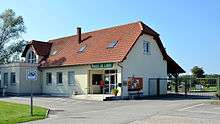Hatten, Bas-Rhin
| Hatten Hàtte | ||
|---|---|---|
| ||
 Hatten | ||
|
Location within Grand Est region  Hatten | ||
| Coordinates: 48°54′09″N 7°58′47″E / 48.9025°N 7.9797°ECoordinates: 48°54′09″N 7°58′47″E / 48.9025°N 7.9797°E | ||
| Country | France | |
| Region | Grand Est | |
| Department | Bas-Rhin | |
| Arrondissement | Haguenau-Wissembourg | |
| Canton | Wissembourg | |
| Government | ||
| • Mayor (2001–2008) | François Fenninger | |
| Area1 | 18.91 km2 (7.30 sq mi) | |
| Population (2006)2 | 1,953 | |
| • Density | 100/km2 (270/sq mi) | |
| Time zone | CET (UTC+1) | |
| • Summer (DST) | CEST (UTC+2) | |
| INSEE/Postal code | 67184 / 67690 | |
| Elevation | 120–172 m (394–564 ft) | |
|
1 French Land Register data, which excludes lakes, ponds, glaciers > 1 km² (0.386 sq mi or 247 acres) and river estuaries. 2 Population without double counting: residents of multiple communes (e.g., students and military personnel) only counted once. | ||
Hatten is a commune in the Bas-Rhin department in Grand Est in north-eastern France, some fifteen kilometres (nine miles) to the south of Wissembourg.
Geography
Positioned at the northern edge of the Forest of Hagenau, the village is on the edge of the Alsace Plain, although the agricultural landscape surrounding this village and its immediate neighbours is one of rolling hills.
History
Second World War

In 1939, Hatten being on the Maginot Line, the authorities arranged for the town's 1,500 inhabitants to be evacuated to Châteauponsac in the Limousin region six hundred kilometres to the southwest. Evacuees were restricted to one suitcase per person, and so were obliged to leave behind most of their possessions. However, after July 1940, the village having survived the invasion of France undamaged, the residents were able to return to Hatten, the whole of Alsace having now reverted to its pre1919 status as a part of Germany.On December 13, 1944, after four years of occupation, the village was liberated without any fighting by the Americans and the residents looked forward to the resumption of peace.
However, in January 1945 the Germans launched one of their final counter-offensives under the name of Operation North Wind, with the intention of retaking Strasbourg. Hatten was on the route of the German columns and this time found itself at the heart of the battle. During the fierce tank battles between the Germans and the Americans that took place during twelve days in the middle January, 350 of the 365 houses with which the village had started the year were destroyed. Along with 2,500 military deaths, January 1945 cost Hatten 83 civilian deaths.
After the war, the village was rebuilt.
See also
References
| Wikimedia Commons has media related to Hatten (Bas-Rhin). |

